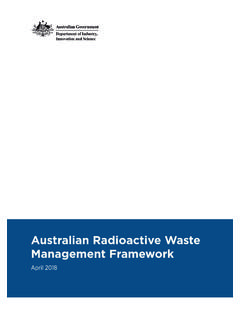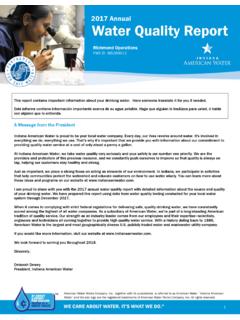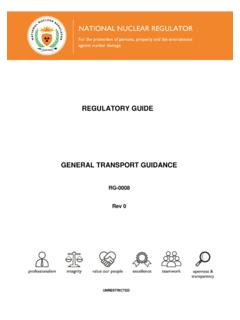Transcription of 9 Radiological aspects - WHO
1 2039 Radiological aspectsDrinking-water may contain radioactive substances ( radionu-clides ) that could present a risk to human health. These risks are normally small compared with the risks from microor-ganisms and chemicals that may be present in drinking-water. Except in extreme circumstances, the radiation dose re-sulting from the inges-tion of radionuclides in drinking-water is much lower than that received from other sources of radiation. The objective of this chapter is to provide criteria with which to assess the safety of drinking-water with respect to its radionuclide content and to provide guidance on reducing health risks by taking measures to decrease radionu-clide concentrations, and therefore radiation doses, in situations where this is considered terms of health risk assessment, the Guidelines do not differentiate between radionuclides that occur naturally and those that arise from human activities.
2 How-ever, in terms of risk management, a differentiation is made because, in principle, human-made radionuclides are often controllable at the point at which they enter the water supply. Naturally occurring radionuclides, in contrast, can potentially enter the water supply at any point, or at several points, prior to consumption. For this reason, n aturally occurring radionuclides in drinking-water are often less amenable to c ontrol. Introduction(Chapter 1)A conceptual framework for implementing the Guidelines (Chapter 2)FRAMEWORK FOR SAFE DRINKING-WATERH ealth-based targets(Chapter 3)Public health context and health outcomeWater safety plans(Chapter 4)SystemassessmentMonitoringManagement and communicationSurveillance(Chapter 5)Application of the Guidelines in specific circumstances(Chapter 6)Climate change, Emergencies, Rainwater harvesting, Desalinationsystems, Travellers, Planes and ships, INFORMATIONM icrobial aspects (Chapters 7 and 11)Chemical aspects (Chapters 8 and 12)Radiologicalaspects(Chapter 9)Acceptabilityaspects(Chapter 10)GUIDELINES FOR DRINKING-WATER QUALITY204 Naturally occurring radionuclides in drinking-water usually give radiation doses higher than those provided by artifi cially produced radionuclides and are therefore of greater concern.
3 Radiological risks are best controlled through a preventive risk man-agement approach following the framework for safe drinking-water (see chapter 2) and the water safety plan approach (see chapter 4). When considering what action to take in assessing and managing Radiological risks, care should be taken to ensure that scarce resources are not diverted away from other, more important public health concerns. The screening levels and guidance levels for radioactivity presented in these Guidelines are based on the latest recommendations of the International Commission on Radiological Protection (ICRP, 2008). Some drinking-water supplies, in particular those sourced from groundwater, may contain radon, a radioactive gas. Although radon can enter indoor air in build-ings through its release from water from taps or during showering, the most signifi cant source of radon in indoor air arises through natural accumulation from the environ-ment.
4 An evaluation of international research data (UNSCEAR, 2000) has concluded that, on average, 90% of the dose attributable to radon in drinking-water comes from inhalation rather than ingestion. Consequently, the setting of screening levels and guidance levels to limit the dose from ingestion of radon contained in drinking-water is not usually necessary. The screening measurements for gross alpha and gross beta activities will include the contribution from radon progeny, which is the principal source of dose from ingestion of radon present in drinking-water supplies. This is further discussed in section Sources1 and health effects of radiation exposure Radioactivity from several naturally occurring and human-made sources is present throughout the environment. Some chemical elements present in the environment are naturally radioactive .
5 These are found in varying amounts in soils, water, indoor and outdoor air and even within our bodies, and so exposure to them is inevitable. In addition, Earth is constantly bombarded by high-energy particles originating both from the sun and from outside the solar system. Collectively, these particles are re-ferred to as cosmic radiation. Everybody receives a dose from cosmic radiation, which is i nfl uenced by latitude, longitude and height above sea use of radiation in medicine for diagnosis and treatment is the largest hu-man-made source of radiation exposure today. The testing of nuclear weapons, rou-tine discharges from industrial and medical facilities and accidents such as Chernobyl have added human-made radionuclides to our environment. The United Nations Scientifi c Committee on the Effects of Atomic Radiation (UNSCEAR, 2008) has estimated that the global average annual dose per person from all sources of radiation in the environment is approximately mSv/year (see Box ).
6 Of this, 80% ( mSv) is due to naturally occurring sources of radiation, (almost mSv) is due to the use of radiation for medical diagnosis and the remaining 1 When the term source appears in this chapter without any other reference, it is used in the context of radiation source . For any other purpose, additional information is provided ( water source ).2059. Radiological aspects (around mSv) is due to other sources of human-made radiation (see Figure ). There can be large variability in the dose received by individual members of the popula-tion, depending on where they live, their dietary preferences and other lifestyle choices. Individual radiation doses can also differ depending on medical treatments and occu-pational exposures. Annual average doses and typical ranges of individual doses from naturally occurring sources are presented in Table (UNSCEAR, 2008).
7 Radiation exposure through ingestion of drinking-waterWater sources can contain radionuclides of natural and artifi cial origin ( human-made):Natural radionuclides, including potassium-40, and those of the thorium and ur- anium decay series, in particular radium-226, radium-228, uranium-234, uranium-238 and lead-210, can be found in water as a result of either natural processes ( absorption from the soil) or technological processes involving naturally occurring radioactive materials ( the mining and processing of mineral sands or phosphate fertilizer production).Human-made radionuclides may be present in water from several sources, such as radionuclides discharged from nuclear fuel cycle facilities; manufactured radionuclides (produced and used in unsealed form in medicine or industry) entered into drinking-water supplies as a result of regular or incidental discharges; radionuclides released in the past into the environment, including drinking-water Key terms, quantities and unitsBecquerel (Bq) The becquerel is the unit of radioactivity in the International System of Units (abbreviated SI from the French Syst me international d unit s), corresponding to one radioac-tive disintegration per second.
8 In the case of drinking-water, it is usual to talk about the activity concentration, expressed in units of Bq/l. Effective dose When radiation interacts with body tissues and organs, the radiation dose re-ceived is a function of factors such as the type of radiation, the part of the body affected and the exposure pathway. This means that 1 Bq of radioactivity will not always deliver the same radia-tion dose. A unit called effective dose has been developed to take account of the differences between different types of radiation so that their biological impacts can be compared directly. The effective dose is expressed in SI units called sieverts (Sv). The sievert is a very large unit, and it is often more practical to talk in terms of millisieverts (mSv). There are 1000 mSv in 1 Sv. Effective half-life Radioisotopes have a physical half-life, which is the period of time it takes for one half of the atoms to disintegrate.
9 Physical half-lives for various radioisotopes can range from a few microseconds to billions of years. When a radioisotope is present in a living organism, it may be excreted. The rate of this elimination is infl uenced by biological factors and is referred to as the biological half-life. The effective half-life is the actual rate of halving the radioactivity in a living organism as determined by both the physical and biological half-lives. Whereas for certain radionuclides, the biological processes are dominant, for others, physical decay is the dominant infl FOR DRINKING-WATER Radiation-induced health effects through drinking-waterRadiation protection is based on the assumption that any exposure to radiation involves some level of risk. For prolonged exposures, as is the case for ingestion of drinking-water containing radionuclides over extended periods of time, evidence of an increased cancer risk in humans is available at doses above 100 mSv (Brenner et al.)
10 , 2003). Below this dose, an increased risk has not been identifi ed through epidemiological studies. It is assumed that there is a linear relationship between exposure and risk, with no threshold value below which there is no risk. The individual dose criterion (IDC) of mSv/year represents a very low level of risk that is not expected to give rise to any detectable adverse health effect. Figure Distribution of average radiation exposure for the world population Table Average radiation dose from naturally occurring sourcesSourceWorldwide average annual effective dose (mSv)Typical annual effective dose range (mSv)External exposureCosmic 1aTerrestrial radiation (outdoors and indoors) 1bInternal exposureInhalation (mainly radon) 10cIngestion (food and drinking-water) 13a Range from sea level to high ground Depending on radionuclide composition of soil and building Depending on indoor accumulation of radon Depending on radionuclide composition of foods and : Adapted from UNSCEAR (2008)Natural sources (Other) sources (Radon) sources (Other) sources (Medical) annual average doses of ionizing radiation per person,by source (mSv)2079.













